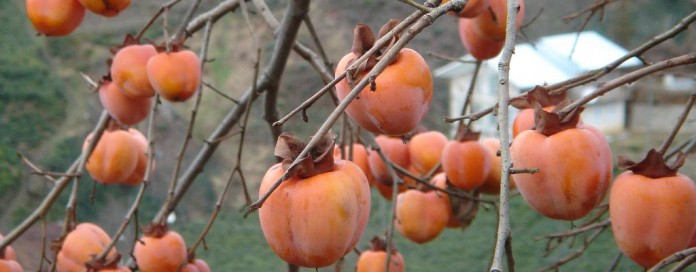On Oct. 18 and 19, temperatures dipped well below freezing for the season’s first hard frost. That sent me to check on a small grove of persimmon trees not far from the house. Frosty nights signal persimmons to ripen, turn from bitter to sweet, and lose their astringent nature. Persimmon is a small, inconspicuous tree that rarely grows taller than 50 feet.
In September, its fruits become obvious, but only female trees bear fruit. When persimmon fruits first form, they are green and inedible. Bite into one in September, and your mouth puckers. It’s a great way to introduce the word “astringent” to outdoor-savvy kids. When Captain John Smith first tasted persimmons near Jamestown, he wrote, “If it be not ripe, it will draw a man’s mouth awrie [sic] with much torment.”
Same experience
I had a similar reaction many years ago. As I recall, it took about 12 hours for my mouth to recover. After a few hard frosts, though, persimmons ripen. As they turn yellow, then orange, they sweeten.
When the skin wrinkles and the flesh softens, persimmons are ready to eat. My wife harvests persimmons each fall. The low hanging fruits seem to drop first, and what remains are far beyond her reach. But that doesn’t stop Linda. She attacks the trunk and shakes the entire tree. The result is a downpour of easily collected sweet fall fruits. Ripe persimmons don’t last long in the wild.
Tasty treat
Pileated woodpeckers, robins, bluebirds and cedar waxwings love them, opossums climb the highest branches for the golden treats, and skunks, foxes, and coyotes gobble those that fall to the ground. Check coyote droppings in the fall and often you’ll find persimmon seeds that have passed through their digestive system unscathed. It’s a trip, in fact, that helps the seeds germinate in the spring.
To propagate persimmons, collect the seeds from ripe fruits (or coyote scats), remove the pulp and air dry for two days. Then sow the seeds about a half-inch deep in a rich soil bed and mulch for winter. It is brightly colored leaves that usually attract my attention this time of year. Two trees in particular are among my favorite.
I’m enjoying them now because the next rainy, windy day is sure to knock most of the leaves to the ground. Flowering dogwood is also one of the most conspicuous trees in the spring. Its showy white flowers appear in April, before most other trees leaf out. That’s why those growing on the edges of the woods are so easy to notice. When I see the dogwoods bloom, I know warblers and other spring migrants will arrive in just a few weeks.
Dogwood flowers
The flowers of this dogwood are a botanical anomaly. Its white “petals” are bracts, not true petals, and they surround the small central flowers. There, a cluster of berries forms, and in the fall they turn bright red. The leaves are a deeper, darker red.
Sassafras trees
Dozens of species of fruit-eating birds relish dogwood berries. Another of my favorite fall trees is sassafras. Though large individuals are not particularly common in our woods, there’s one large specimen on a wooded hillside I can see from the house.
In October, its leaves turn bright reddish-orange, and it sticks out like a scarlet tanager on a verdant May morning. Unlike most trees, sassafras leaves come in three distinct shapes. Most are simple ovals, but some resemble a three-fingered hand, and a few are shaped like mittens. The mitten-shaped leaves appear in both left- and right-handed forms.
Sassafras twigs and roots are pleasantly aromatic when cut, so it’s no surprise that Native Americans and early settlers enjoyed sassafras tea. Though a few sassafras fruits cling tenaciously to their bright red stems, by early November most fruits are gone. The shiny blue-black oval berries measure about a half-inch long.
Turkeys, pileated woodpeckers, catbirds, robins and bluebirds insure that none of the sassafras fruits makes it to January. Collect some colorful sassafras and flowering dogwood fruits and leaves this week, add a shriveled persimmon or two, and you’ll have a nice natural centerpiece for Thanksgiving dinner.













